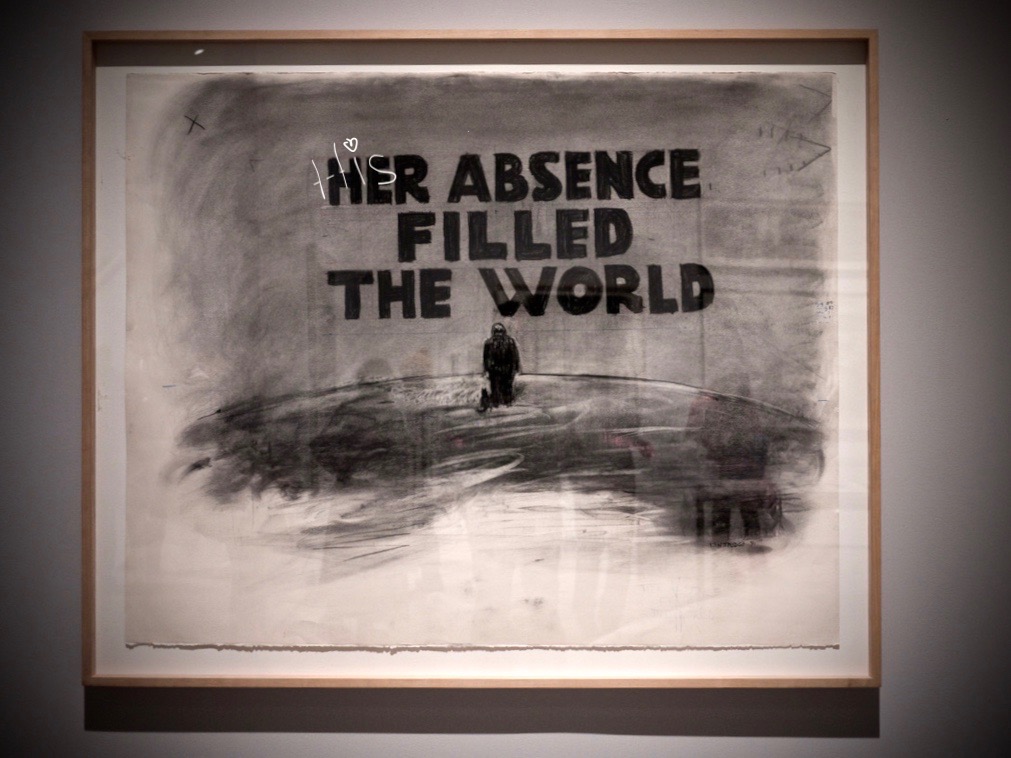Jordan Michael Bell was born on Tuesday, April 14, 1987 at 4:30 in the afternoon after being carried in my womb for almost 39 weeks. It was a very special day in our family as we eagerly welcomed the arrival of a new baby boy and our second son into the world.
Today would have been Jordan’s 31st birthday.
I am reminded of the artwork of William Kentridge that a friend photographed several years ago after he viewed this work at the Modern Museum of Art in New York. Somehow these few words say it all…”his absence filled the world”. (I apologize to the artist for defacing his work.)
My dear friend and colleague, Nancy, sent me an article this week asking if I thought I’d be ready to read it. The author, Theodore George* eloquently explores the experience of grieving. He argues against the stage model of grief saying, “whatever else grieving involves, grieving confers to memory the monstrous challenge of cherishing, protecting, and fostering a relation with one who, because dead, is no longer able to relate to us, as they say, in the flesh.” And because our memory is constantly at work, he takes up Gadamer’s ideas to mean that “our efforts to understand are thus really nothing else than efforts to recollect, to collect again, always in new and different manners, meaning that remains available to us from the past” and particularly about special life events, books, experiences, and people that are, “inexhaustible in their significance.”
The author cites the evocative words of the poet Paul Celan, “the world is gone, I must carry you”.
Just as I carried Jordan for 39 weeks inside my body and carried him in my mothering for over 30 years, I joyfully continue to carry him: “this ethical demand to carry the memory of the deceased into the future is, at the same time, a promise of novelty, both for ourselves and for the memory of our friend or loved one as we seek to carry on unaccompanied.”
*George, T. (2017). Grieving as limit situation of memory: Gadamer, Beamer, and Moules on the infinite task posed by the dead. Journal of Applied Hermeneutics. Retrieved from http://jah.journalhosting.ucalgary.ca/jah/index.php/jah/article/view/163
I’d also recommend reading:
Beamer, K. (2017). And Coyote howled: Listening to the call of interpretive inquiry. Journal of Applied Hermeneutics. Retrieved from http://hdl.handle.net/10515/sy5n010b1
Moules, N. J. (2017). Grief and hermeneutics: Archives of lives and the conflicted character of grief. Journal of Applied Hermeneutics, Editorial 1. Retrieved from http://hdl.handle.net/10515/sy5h708h8
Moules, N. J., Simonson, K., Fleiszer, A. R., Prins, M., & Glasgow, B. (2007). The soul of sorrow work: Grief and therapeutic interventions with families. Journal of Family Nursing, 13(1), 117-141. https://doi.org/10.1177/1074840706297484. Can also be retrieved from https://dspace.ucalgary.ca/bitstream/handle/1880/45193/Moules_etal_2007_Soul_of_Sorrow_edited.pdf?sequence=3
Moules, N. J., Simonson, K., Prins, M., Angus, P. & Bell, J. M. (2004). Making room for grief: Walking backwards and living forward. Nursing Inquiry, 11(2) 99–107. https://doi.org/10.1111/j.1440-1800.2004.00204.x
Moules, N. J., Thirsk, L. M., & Bell, J. M. (2006). A Christmas without memories: Beliefs about grief and mothering–A clinical case analysis. Journal of Family Nursing, 12(4), 426-441. https://doi.org/10.1177/1074840706294244. Can also be retrieved from https://prism.ucalgary.ca/bitstream/handle/1880/45180/Christmas.pdf;jsessionid=E8F83AAF786903A14BB0745A1183758C?sequence=3
